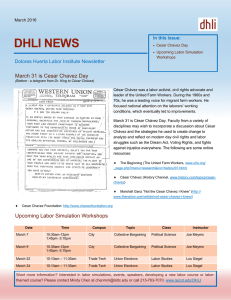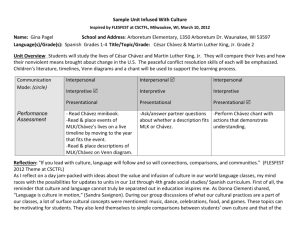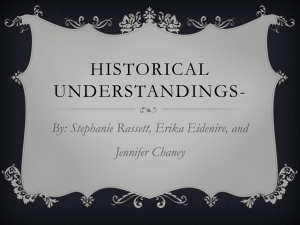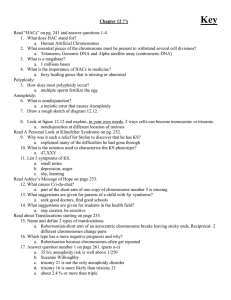March is Trisomy Awareness Month
advertisement
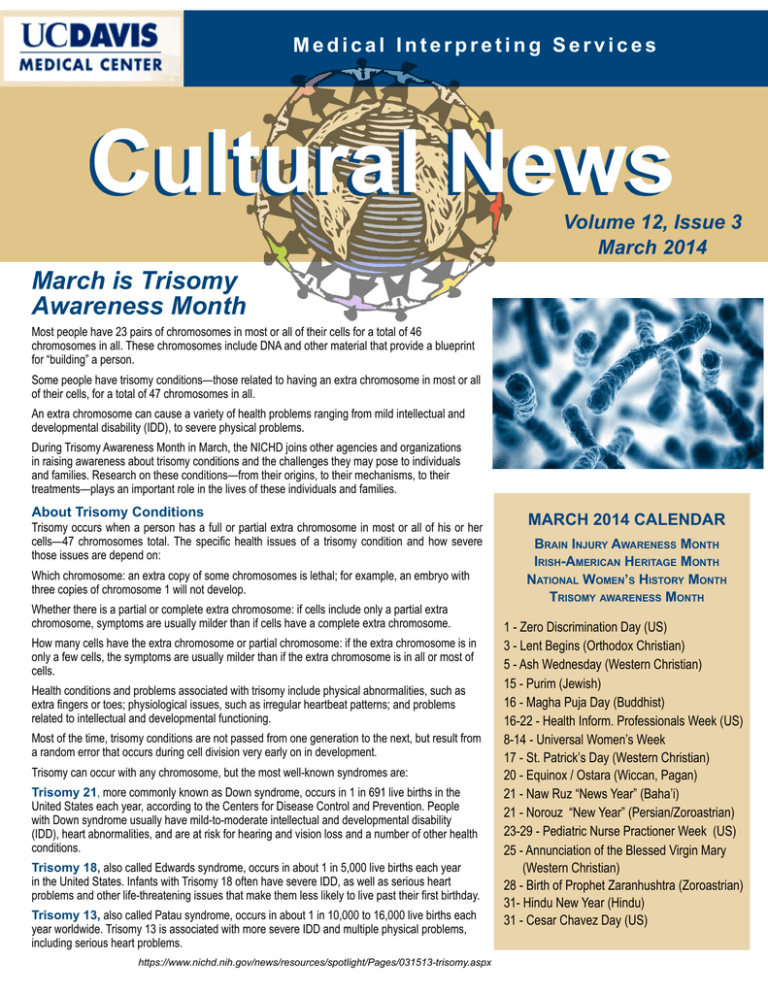
Medical Interpreting Services Cultural News Volume 12, Issue 3 March 2014 March is Trisomy Awareness Month Most people have 23 pairs of chromosomes in most or all of their cells for a total of 46 chromosomes in all. These chromosomes include DNA and other material that provide a blueprint for “building” a person. Some people have trisomy conditions—those related to having an extra chromosome in most or all of their cells, for a total of 47 chromosomes in all. An extra chromosome can cause a variety of health problems ranging from mild intellectual and developmental disability (IDD), to severe physical problems. During Trisomy Awareness Month in March, the NICHD joins other agencies and organizations in raising awareness about trisomy conditions and the challenges they may pose to individuals and families. Research on these conditions—from their origins, to their mechanisms, to their treatments—plays an important role in the lives of these individuals and families. About Trisomy Conditions Trisomy occurs when a person has a full or partial extra chromosome in most or all of his or her cells—47 chromosomes total. The specific health issues of a trisomy condition and how severe those issues are depend on: Which chromosome: an extra copy of some chromosomes is lethal; for example, an embryo with three copies of chromosome 1 will not develop. Whether there is a partial or complete extra chromosome: if cells include only a partial extra chromosome, symptoms are usually milder than if cells have a complete extra chromosome. How many cells have the extra chromosome or partial chromosome: if the extra chromosome is in only a few cells, the symptoms are usually milder than if the extra chromosome is in all or most of cells. Health conditions and problems associated with trisomy include physical abnormalities, such as extra fingers or toes; physiological issues, such as irregular heartbeat patterns; and problems related to intellectual and developmental functioning. Most of the time, trisomy conditions are not passed from one generation to the next, but result from a random error that occurs during cell division very early on in development. Trisomy can occur with any chromosome, but the most well-known syndromes are: Trisomy 21, more commonly known as Down syndrome, occurs in 1 in 691 live births in the United States each year, according to the Centers for Disease Control and Prevention. People with Down syndrome usually have mild-to-moderate intellectual and developmental disability (IDD), heart abnormalities, and are at risk for hearing and vision loss and a number of other health conditions. Trisomy 18, also called Edwards syndrome, occurs in about 1 in 5,000 live births each year in the United States. Infants with Trisomy 18 often have severe IDD, as well as serious heart problems and other life-threatening issues that make them less likely to live past their first birthday. Trisomy 13, also called Patau syndrome, occurs in about 1 in 10,000 to 16,000 live births each year worldwide. Trisomy 13 is associated with more severe IDD and multiple physical problems, including serious heart problems. https://www.nichd.nih.gov/news/resources/spotlight/Pages/031513-trisomy.aspx MARCH 2014 CALENDAR Brain Injury Awareness Month Irish-American Heritage Month National Women’s History Month Trisomy awareness Month 1 - Zero Discrimination Day (US) 3 - Lent Begins (Orthodox Christian) 5 - Ash Wednesday (Western Christian) 15 - Purim (Jewish) 16 - Magha Puja Day (Buddhist) 16-22 - Health Inform. Professionals Week (US) 8-14 - Universal Women’s Week 17 - St. Patrick’s Day (Western Christian) 20 - Equinox / Ostara (Wiccan, Pagan) 21 - Naw Ruz “News Year” (Baha’i) 21 - Norouz “New Year” (Persian/Zoroastrian) 23-29 - Pediatric Nurse Practioner Week (US) 25 - Annunciation of the Blessed Virgin Mary (Western Christian) 28 - Birth of Prophet Zaranhushtra (Zoroastrian) 31- Hindu New Year (Hindu) 31 - Cesar Chavez Day (US) Cultural News • March 2014 New Interpreter Profile: Mai Saechao Mai Saechao is the newest member of the Medical Interpreting Services Mienlanguage team. Prior to joining UC Davis Medical Center, she worked as a Mien medical interpreter for local language agencies. She is currently pursuing a degree in Health Science at Californiat State University, Sacramento, and is very proud to be on the Dean’s Honor list. During her spare time, Mai enjoys hosting small dinners for family and friends. It gives her an opportunity to enjoy great company and wonderful food. Mai loves the outdoors. She gets in touch with nature and the beautiful surroundings by going on hiking trips. “I feel honored to join UC Davis Medical Center as a professional interpreter. Communication between patients and providers is very important, and Medical Interpreting Services department does a wonderful job of bridging the linguistic and cultural gap” - says Mai. Welcome on-board, Mai! Longz hnyouv duqv zipv meih! César Chávez Day in United States César Chávez Day is observed in the United States on March 31 each year. It celebrates the birthday of César Estrada Chávez, and it serves as a tribute to his commitment to social justice and respect for human dignity. What do people do? César Chávez Day celebrations are held in many parts of the United States. It is a state holiday in California and an optional holiday in states such as Colorado and Texas, but its celebrations go beyond these three states. Other states where celebrations and various activities occur in honor of Dr Chávez include Arizona, Michigan, Nebraska and New Mexico. Key community leaders use this event to speak to the public about values that Dr Chávez showed in his lifetime and how they made a positive impact on society. Discussions, debates and media attention may focus on issues that Dr Chávez was actively involved with. These issues are relevant to Americans today and center on worker’s rights, fair wages, pension benefits, and medical coverage. Many schools have classroom activities that focus on Dr Chávez’s achievements, writings and speeches on or close to César Chávez Day. Community and business breakfasts or luncheons are also held to honor Dr Chávez’s achievements and incite hope within American communities. Public life César Chávez Day is a state holiday in California so government offices, educational institutions and many businesses are closed. State government offices in Colorado may grant requests for César Chávez Day in lieu of another holiday in the same fiscal year. However, government offices must be open. César Chávez Day is an optional state holiday in Texas. Dr Chávez co-founded the National Farm Workers Association in the early 1960s. He focused attention on the plight of migrant farm workers and gained support to have his organization be the first successful farm workers’ union in the United States. He used principles of non-violence, with strikes and boycotts. Dr Chávez remained president of United Farm Workers of America (AFL-CIO) until his death on April 23, 1993. Funding for César Chávez Day was temporarily suspended in California around 2004 due to problems with the budget in the state. The courts were divided about the holiday in 2005, where some legal staff workers attended work but the doors to court rooms and filing offices were locked. Current efforts are made to push for César Chávez Day to become a national holiday in the United States. Symbols Many schools, community centers and parks are named after Dr Chávez in the United States. For example, there is the César Chávez Elementary School in San Francisco. There is also a portrait of Dr Chávez in the National Portrait Gallery in Washington DC, as well as a statue of him at the University of Texas in Austin. Dr Chávez is listed in the California Hall of Fame and references have been made about him in songs by wellknown musicians. He was also honored with a commemorative postage stamp that the United States Postal Service issued in 2003. http://www.timeanddate.com/holidays/us/cesar-chavez-day Background César Chávez was born on March 31 in 1927. He was a migrant farm worker from the age of 10. He became active with the Community Service Organization, which helped fight racial and economic discrimination against Chicano residents. This issue of Cultural News was produced by UC Davis Medical Interpreting Department editorial team. Questions? Comments? Please call Medical Interpreting Services at 916/734-2321 or e-mail malithone.thongsonlone@ucdmc.ucdavis.edu
